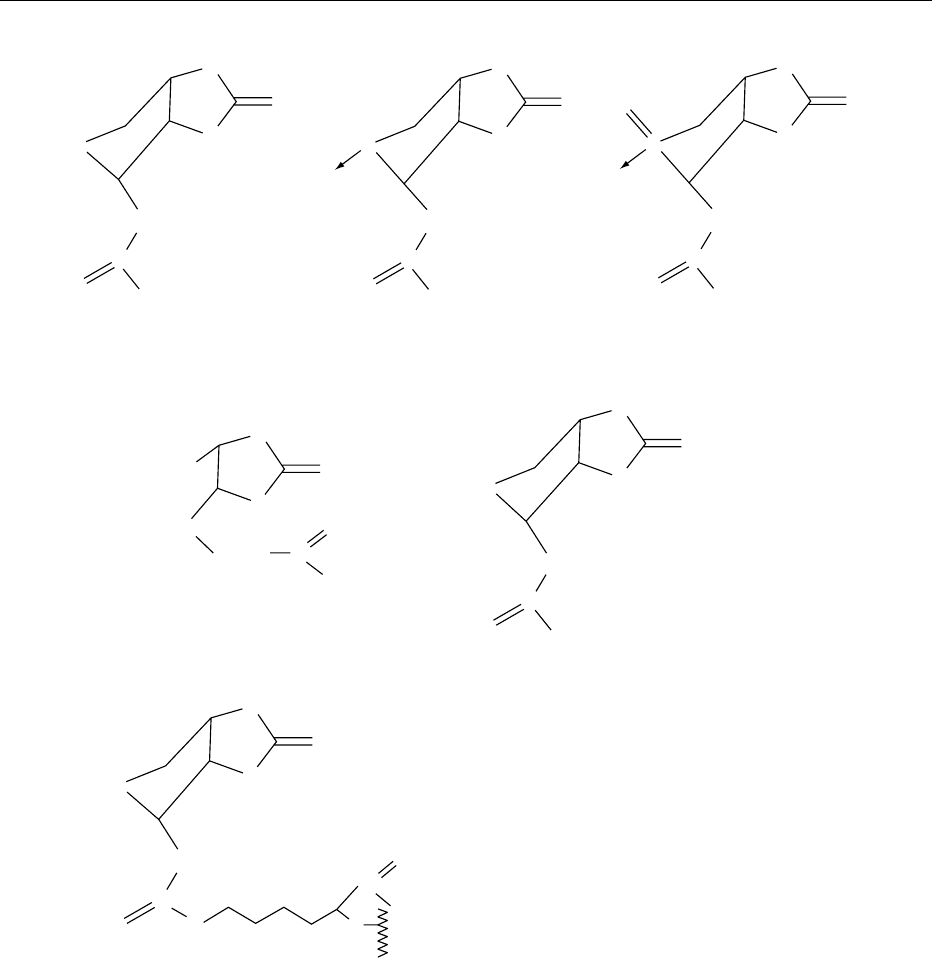Caballero B. (ed.) Encyclopaedia of Food Science, Food Technology and Nutrition. Ten-Volume Set
Подождите немного. Документ загружается.


importance in the production of fermented beverages.
Commercial purified pectinolytic enzymes have been
applied to improve clarification processes and aroma
and color compound extraction, in beverage indus-
tries. The beverage industry has used genetic engin-
eering techniques mainly for the selection of yeasts.
Biotechnology in Cereal Industries
0057 The most important field has been fermentation. Isol-
ation and characterization of both desirable and
undesirable microorganisms (pathogens) have been
carried out. The role of cereal as a substrate to obtain
antimutagenic or anticarcinogenic fungic compounds
has been evaluated.
0058 The cereal breeding industry is also investigating
the application of genetic techniques to improve
major grain parameters (e.g., resistance to herbicides,
viruses, fungal disease, temperature variations).
Biotechnology in Dairy Industries
0059 A great deal of research has been carried out on
selection, industrial production conditions, immobil-
izing processes, and applications of different dairy
starters. The most studied microorganisms group
has been the lactic acid bacteria (LAB), which have
been applied to improve and increase industrial
productions of traditional food, without any loss of
popular acceptance; to increase the nutritional and
health value of dairy foods; to increase selected
flavor generation; and to improve the texture of
dairy products.
0060 Potential health benefits of bifidobacteria have
been studied, and their application in yogurt and
cheese production has been described. Some LAB
have been genetically modified to utilize the lactose,
and have been applied to obtain new yogurts with a
sweet alanine flavor, longer shelf-life, or improved
clinical probiotic value.
0061 Other important studies have been concerned with
the isolation of microbial enzymes, developments in
GM enzymes, and their application in dairy indus-
tries. Clotting enzymes (chymosin), proteases, and
lipases are the most studied and applied. Immobilized
or free lipases have been used in many different
aspects, such as for the production of food additives
(e.g., antioxidants by esterification of phenols) and
desirable flavors (e.g., in cheese, buttermilk), for syn-
thesis of flavor thioesters, or as emulsifiers or food
spoilage agents. Immobilized esterases have been
employed in butter oil to obtain dairy flavor products.
Thermally stable microbial b-glycosidase has been
used to avoid problems of human lactose intolerance.
0062 Some microorganisms are selected to improve
the safety of dairy products, which are able to
biosynthesize biopreservative compounds (e.g., reute-
nin). Different biotechnological practices (selected
microorganisms or their metabolites) can be applied
to control and predict bacteriophage contamination
in dairy products, and bacteriocins isolated from dif-
ferent cultures have been applied to render inactive
milk pathogens.
0063Many papers on probiotic dairy food have been
published in relation to mechanisms, underlying
their effects on human health, and some microorgan-
isms have been applied to reduce the level of choles-
terol and increase the availability of provitamin D
3
.
0064Recent works have studied the use of genetic engin-
eering to modify the composition of milk indirectly by
using transgenic animals. These studies have been
carried out to obtain low-lactose milk or to improve
the quality of milk (increasing the fat level) to make
special cheeses such as mozzarella.
0065Different papers have shown biotechnological ap-
plications on dairy effluents such as cheese whey.
Microbial fermentation of whey for the production
of biosurfactant sophorolipids or some enzymes with
important industrial and environmental applications
has been described.
Biotechnology in the Meat-product Industries
0066Fermentation processes in order to increase microbial
activities and the production of bacteriocins have
been extensively studied with satisfactory results,
and new starter cultures (LAB) have been developed.
0067In addition, different kinds of proteinases alone or
accompanied by lipases and esterases have been stud-
ied and applied usefully for the tenderization and
ripening of meats and their products. Proteinases
have been also used to hydrolyze peptides isolated
from different animal meats to obtain new flavors.
0068In meat production, amylases, cellulases, and pec-
tinases have been mixed and applied to obtain new
animal feed, which increases the body weight and the
percentage of protein and ash of the meat.
0069The main genetic technique used is the polymerase
chain reaction, which uses a DNA-based identifica-
tion system for testing the species origin of meat
samples and is suitable for authenticating processed
meat products.
Biotechnology in the Fish-product Industries
0070The development of new fermented products (fish
and sauces) with special attention on desirable sens-
ory properties has been one of the most important
fields of study in these industries.
0071The second field has been the production of o-3
polyunsaturated fatty acids, using immobilized lipase,
or looking for marine organisms (bacteria, microalga,
BIOTECHNOLOGY IN FOOD PRODUCTION 505

fungi, and zooplankton) that can biosynthesize these
acids.
0072 Other applications have been the use of different
enzymes for the tenderization and ripening of fish and
to obtain new flavors. Fish enzymes and proteins have
been isolated and applied in the food industry. LAB
and their bacteriocins isolated from fish intestines
have been genetically characterized, and their poten-
tial use in food preservation evaluated.
See also: European Union: European Food Law
Harmonization; Food and Drug Administration; Food
and Agriculture Organization of the United Nations;
Genetically Modified Foods; Legislation: International
Standards; Codex; World Health Organization
Further Reading
Altman A (1998) Agricultural Biotechnology. New York:
Marcel Dekker.
European Federation of Biotechnology (EFB) Task Group
on Public Perceptions of Biotechnology (1997). Biotech-
nology in Foods and Drinks Inform. London, UK: EFB
IFT (2000) Genetically modified organisms. Food Technol-
ogy 54: 42–45.
Kaufman PB, Cseke LJ, Warber S, Duke JA and Brielmann
HL (1999) Natural Products from Plants. Boca Raton,
FL: CRC Press.
Lappe M and Bailey B (1999) Against the Grain. The
Genetic Transformation of Global Agriculture. London:
Earthscan Publications.
Lee BH (1996) Fundamentals of Food Biotechnology. New
York: VCH Publishers.
Menrad K, Agrafiotis D, Enzing CM, Lemkow L and Ter-
ragni F (1999) Future Impacts of Biotechnology on
Agriculture, Food Production and Food Processing.
London: Springer.
Nelson GC (2001) Genetically Modified Organisms in
Agriculture, Economics and Politics. London: Academic
Press.
Pandey A, Benjamin S, Soccol CR et al. (1999) The realm of
microbial lipases in biotechnology. Biotechnology and
Applied Biochemistry 29: 119–131.
Ratledge C and Kristiansen B (2001) Basic Biotechnology.
Part I and II. New York: Cambridge University Press.
Roller S and Harlander S (1998) Genetic Modification in
the Food Industry: A Strategy for Food Quality Im-
provement. London: Blackie Academic & Professional.
Ryan-Harshman M (1998) Food biotechnology: food
industry, nutrition and public health. Proceedings of
the Nutrition Society 56: 845–854.
Shahidi F, Jones Y and Kitts DD (1997) Seafood Safety,
Processing and Biotechnology. Basle: Technomic Pub-
lishing.
Thompson PB (1997) Food Biotechnology in Ethical Per-
spective. London: Blackie Academic & Professional.
Tzotzos GT and Skryabin KG (2000) Biotechnology in the
Developing World and Countries in Economic Transi-
tion. Wallingford, UK: CABI Publishing.
BIOTIN
Contents
Properties and Determination
Physiology
Properties and Determination
R Bitsch, Friedrich-Schiller-University, Jena, Germany
Copyright 2003, Elsevier Science Ltd. All Rights Reserved.
Biotin
0001 The molecular structure of biotin is characterized by
three chiralic C atoms leading theoretically to eight
stereoisomers. Only the d(þ)-isomer is biologically
active. The most commonly used microbiological
assays (bioassays) for quantitation are more recently
replaced by protein binding assays, with avidin
showing higher precision and enhanced detection
limits. Besides these methods, biotin can also be ana-
lyzed mainly in pharmaceuticals using photometric
and fluorometric procedures or chromatographic
techniques (TLC and HPLC).
Properties
0002The molecular structure of biotin (CAS No. 58–85–5)
is a bicyclic ring system comprising an imidazolidone
ring fused with a tetrahydrothiophene ring that is
substituted with a valeric acid side chain. The stereo-
chemistry reveals that both ring systems are fused in a
506 BIOTIN/Properties and Determination

boat-like configuration at an angle of 62
(Figure 1).
The chemical nomenclature of this compound is like a
cis-hexahydro-2-oxo-1H-thieno[3,4-d] imidazole-4-
pentanoic acid as was elucidated by Ko
¨
gl 1937 and
Du Vigneaud in 1941. The molecule contains three
chiralic centers (*), and so eight stereoisomers are
possible. Only the d-(þ) isomer with a cis-configur-
ation at the chiralic centers possesses vitamin activity
and is found in natural products. The empiric formula
is C
10
H
16
N
2
O
3
S (molecular weight 244.3 Da). The
molecular structure was confirmed in 1943 by Harris
et al., who were the first to achieve total biotin syn-
thesis. In the meantime, a stereospecific synthesis for
commercial production was developed by Goldberg
and Sternbach in 1949.
Physicochemical Characteristics
0003 d-Biotin as a free acid with a pK
a
value of 4.51
crystallizes in colorless needles with a melting point
of 230–232
C (decomposition). The substance is
slightly soluble in water (0.82 mM ¼0.2 g l
1
at
25
C) and ethanol 95% (3.27 mM ¼0.8 g l
1
),
readily soluble in dilute alkali, and almost insoluble
in most organic solvents. The specific optical rotation
[a]
d
22
in 0.1 N NaOH is þ 92
C(c ¼0.3) (Table 1).
0004Crystalline d-biotin is fairly stable on exposure to
air, daylight, and heat. Gradual destruction is ob-
served on exposure to ultraviolet radiation. In weakly
acid or alkaline solutions between pH 4.0 and 9.0, it
is relatively stable, too. The molecule is also resistant
to autoclaving in 2 N or 6 N sulfuric acid for 2 h (the
commonly used extraction procedure).
0005Biotin is, however, susceptible to oxidation at the
sulfur atom of the thiophene ring with the sequential
formation of biotin sulfoxide and biotin sulfone. This
oxidation, which is negligible in concentrated solu-
tions, provides a primary step for vitamin activity
losses in processed foods producing a mixture of d-
and l-sulfoxides. While d-biotin sulfoxide exhibits a
similar growth promoting activity for some micro-
organisms to that of biotin (e.g. Lactobacillus and
Saccharomyces sp.), subsequent oxidation to biotin
sulfone leads to complete loss of the biological activ-
ity. Biotin sulfoxide also seems to be a product of the
biotin metabolism and can be detected as a minor
excretion component in urine. In addition, microbial
growth can drastically lower the concentration of
nonsterile dilute solutions of this vitamin.
0006Besides the sulfoxide and sulfone, further metabol-
ites and analogs have been identified as intermediate
products of the biosynthesis (e.g., dethiobiotin) or
of the metabolism (e.g., bis- and tetranorbiotin) in
bacteria, yeasts, and fungi or as byproducts of the
chemical synthesis (e.g., oxybiotin) (Figure 2). The
growth response of microorganisms to these analogs
is variable and thus may lead to conflicting results in
terms of vitamin activity in biological samples when
measured by means of microbial assays (see Table 2).
Bisnorbiotin, tetranorbiotin, and biotin sulfone, as
well as other derivatives, are potent antagonists of
biotin and do not support microbial growth. Apart
from the sulfoxide and sulfone, these analogs are of
little practical importance in foods. Nevertheless,
more recent results indicate that in human urine
samples, besides unchanged biotin, about 11%
d-biotin-sulfoxide, 29% bisnorbiotin, and 4% biotin
sulfone plus bisnorbiotinmethyl-ketone and tetra-
norbiotin-l-sulfoxide could be identified, but no
CH
2
CH
2
CH
2
CH
2
2
1
S
5
62˚
H
*
*
*
H
3
4
1'
2'
3'
N
H
H
O
N
H
H
C
OH
O
fig0001 Figure 1 D(þ)-Biotin. *, chiralic centers.
tbl0001 Table 1 Physicochemical properties of biotin
Brutto formula Molecular weight Melting point Specific opticalrotation
C
10
H
16
N
2
O
3
S 244.3 Da 230–232
C (decomposition) [a]
D
22
¼þ92
(0.1 N NaOH, c ¼ 3.0)
Solubility
Water Ethanol (95%) Lipophilic solvent Dilute alkali
0.82 mM ¼ 0.2 g l
1
(25
C) 3.27 mM ¼ 0.8 g l
1
Insoluble Readily soluble
BIOTIN/Properties and Determination 507

degradation products of the cyclic urea ring were
found to be excreted.
0007 In natural products, biotin exists either in free form
or protein-bound. Generally, the free form predomin-
ates in plant food, whereas a greater part in animal
food is protein-bound. Therefore, less drastic hy-
drolysis with 2 N sulfuric acid is required to liberate
biotin from plant material than from products
of animal origin, which need 6N sulfuric acid.
The biotin content in selected foods is shown in
Table 3.
0008If protein-bound, the vitamin is linked through an
amide bond between the carboxyl group of the valeric
acid side chain and an e-amino group of terminating
lysine. This e-N-biotinyl-l-lysine (biocytin) is natur-
ally occurring, too, and is partly formed by proteo-
lysis of biotin enzymes. Occasionally, biocytin is
indicated as the real prosthetic group of biotin-
dependent enzymes.
0009The most prominent antagonist of biotin is avidin.
This is a glycoprotein from egg white with a MW of
68 000, which is formed within the oviduct of avian
H
N
H
H
H
C
OH
O
S
O
O
N
(CH
2
)
4
H
N
H
H
H
C
OH
O
S
O
N
(CH
2
)
n
H
N
H
H
H
C
OH
Oxybiotin Biotinsulfoxide
Dethiobiotin
Biocytin (ε-N-Biotinyl-
L-lysine)
Biotinsulfone
O
O
O
N
(CH
2
)
4
(CH
2
)
4
H
3
C
H
2
C
H
N
H
C
O
OH
H
H
O
N
H
N
H
H
H
C
N
H
O
S
O
N
(CH
2
)
4
H
N
H
H
H
C
OH
O
S
O
O
O
N
(CH
2
)
4
C
O
OH
N
H
enzyme
n = 2, Bisnorbiotin
n = 0, Tetranorbiotin
fig0002 Figure 2 Biotin derivatives and analogs.
508 BIOTIN/Properties and Determination

species and reptiles. It has a tetrameric structure with
four identical subunits (MW 17 000), each containing
a binding site for biotin, so 4 moles of biotin are
bound by 1 mole of avidin.
0010 The interaction of avidin with biotin is the
strongest noncovalent binding ever found in living
organisms with a dissociation constant of the binding
sites, K
d
¼ 10
15
M. Because avidin is a basic protein
with an isoelectric point of pH 10.5, by oral intake,
not only the dietary but also the enterally synthesized
and enzymatically bound biotin can be irreversibly
bound. The avidin–biotin complex is not cleaved
within the gastrointestinal tract.
0011 Raw egg white contains 2 mg of avidin per 100 g,
so about 15 mg of biotin are fixed by one egg (c.50 g)
and made unavailable for man and animal. Not only
free or enzymatically bound biotin but the structural
isomers with an intact ureido ring in the cis configur-
ation compete for complexing, too, as is shown in
Table 4. The very stable avidin–biotin complex is
only split by autoclaving with strong acid. Avidin,
however, is only in raw egg white active as an inhibi-
tor of the biotin availability and is denaturated by
heat, thereafter losing its binding capacity.
0012The exact physiological role of avidin is not well
understood, but it is generally thought to be effective
as a bacteriostat. With respect to the stoichiometric
binding, avidin has served as a useful diagnostic tool
in the identification and study of biotin-dependent
enzymes.
0013Besides avidin, streptavidin (MW 60 000) has been
isolated from Streptomyces avidinii, which is also
composed of four subunits with a biotin-binding
affinity similar to that of avidin. On the basis of
the stoichiometric binding of biotin by avidin and
streptavidin in a stable complex, current analytical
methods to quantitate biotin and its metabolites in
biological materials have been developed.
Determination
Microbiological Assays
0014As with other B vitamins, biotin has been exclusively
assayed for longer times by microbiological methods.
Biotin is a growth factor for a variety of bacteria,
fungi, yeasts, and flagellatae. For assay purposes, in
foods and other biological materials such as blood,
plasma/serum, urine, and various tissues (liver, brain),
Lactobacillus plantarum, L. casei, Saccharomyces
cerevisiae, Neurospora crassa,andOchromonas
danica have been used. Besides the variable response
to biotin analogs, as shown in Table 2, the lack of
specifity is also due to certain amino acids, fatty acids
and their metabolites, which are able to stimulate the
growth and replace biotin, thus affecting the validity
of the assay. Results achieved with different microbial
assays are often therefore hardly comparable,
particularly if the relationship of biotin to these
interfering factors is poor.
tbl0002 Table 2 Growth response of biotin derivatives to some microorganisms
Microorganism Biotin-
D -sulfoxide Oxybiotin D-Dethiobiotin Biocytin
Lactobacillus plantarum (ATCC 8014) þþ þ þ
Lactobacillus casei (ATCC 7469) þþþ
Ochromonas danica þþ
Saccharomyces cerevisiae (ATCC 7754) þþ (þ) þþ þþ
Neurospora crassa þþþþ
Kloeckeria brevis (ATCC 9774) þþ þþ
þþ, identical activity to equimolar biotin; þ, about half of the activity of equimolar biotin; , no growth response.
tbl0003 Table 3 Biotin content in selected foods
a
Food Biotin content
(mgper100g)
Nutrient
density (mg
biotin per
10 0 0 kcal or
4.2 MJ)
Fruits
Apples, apricots, bananas,
grapefruits, pears, strawberries
0.4–5.5 8–125
Vegetables
Asparagus, cauliflower, peas,
potatoes, spinach, tomatoes
1–4 51–314
Eggs (whole) 25 162
Nuts
Almonds, peanuts, walnuts 10–34 18–61
Milk and cheese
Whole milk, brie, gouda 1.5–6 4–54
Meat
Pork and beef, lean 4–5 27–28
Liver
Pork and beef 23–92 194–536
Fish
Cod, herring, redfish, trout 2–10 22–80
Cereals
Wheat flour, oats, rice polished,
rice (wholegrain), rye
(wholemeal)
1.5–17 4.5–34
a
Modified, according to the databases of Bundeslebensmittelschl
u
¨
ssel ll.2,
1996, of the Bundesinstitut f
u
¨
r gesundheitlichen Verbraucherschutz und
Veterina
¨
rmedizin, Berlin, with permission.
BIOTIN/Properties and Determination 509

0015 Minor growth activity for L. plantarum exhibits
oleic acid, elaidinic acid, linoleic and linolenic acid, as
well as a few other lipids, which have to be removed
either by filtration or by ether extraction. Aspartate
and several other amino acid metabolites, pimelic
acid, and oleic acid interfere with the Saccharomyces
assay. Less frequently used microorganisms are N.
crassa and O. danica, although O. danica is rather
specific and responds, besides biotin, only to biocytin
and protein-bound vitamin. The O. danica assay was
applied for biotin assessments in blood, serum, urine,
liver, brain, and muscle. The validity of the method
established by recovery experiments was demon-
strated to 96–103% biotin recovery.
0016 In order to extract the vitamin, in most assays, the
biological material is subjected to acid (sulfuric acid)
or enzymatic hydrolysis. Protein-bound biotin is also
cleaved by papain, a proteolytic enzyme hydrolyzing
specifically lysine-bound substances.
0017 Principle of the Lactobacillus plantarum (ATCC
8014, formerly L. arabinosus) assay To liberate
protein-bound biotin, foods, feeds and other bio-
logical samples are extracted with sulfuric acid for
2 h at 121
C. Plant products as well as whole blood,
plasma, and urine samples are autoclaved with 2 N
sulfuric acid, and animal samples otherwise with
6 N sulfuric acid. The ratio of sample to acid should
be 1:20, whole blood, plasma or urine at a ratio of
3 ml of sample to 8 ml of acid. For pharmaceuticals
and premixes, dilution with 0.1 N sodium hydroxide
at a concentration of about 0.2 ng ml
1
and, if needed,
centrifugation or filtration to clarify is the preferred
extraction mode. Stronger acid concentrations for
sample extraction should be avoided, because a high
sodium sulfate concentration in the assay is inhibitory
to the test organism. Furthermore, using strong sul-
furic acid, followed by autoclaving, biotin may be
partly oxidized to inactive biotin sulfone.
0018 Hydrochloric acid should not be used in place of
sulfuric acid, as the hydrochloric acid may inactivate
biotin probably because of the presence of chlorine.
High-fat samples must be extracted, prior to acid
cleavage, with hexane or ethyl ether to avoid fatty
acid stimulation.
0019After cooling, the samples are adjusted to pH 6.75
with concentrated NaOH, and biotin in the extract is
determined by means of its growth response to an
inoculum suspension prepared from a stock culture
of L. plantarum and diluted with culture medium.
After incubation at 37
C, the absorbance (nephelo-
metric) is measured at 660 nm, and the biotin content
is calculated by comparing with a standard curve
using d(þ)-biotin concentrations of up to 0.80 ng
per 5 ml. The detection limit of this microbiological
assay is 122 pg biotin ml
1
(0.5 pmol ml
1
). The co-
efficient of variation (CV) for whole blood analysis
amounts to about 19%.
0020A modification of the standard biotin assay
with L. plantarum has been developed by a radiomet-
ric-microbiological assay (RMA) based on the
measurement of
14
CO
2
from the metabolism of l-1-
[
14
C]-methionine by Kloeckeria brevis (ATCC 9774).
The amount of
14
CO
2
is measured with the aid of a gas-
flow ionization chamber system and is proportional to
the present biotin amount. The assay sensitivity
has been found to be 10 pg of biotin (41 fmol)/vial
(¼5.2 ml). This test has been employed for plasma,
as well as food, analysis. Biocytin and biotin-d-sulf-
oxide have the same biological activity as biotin in
equimolar concentrations, but dethiobiotin and other
analogs as well as fatty acids and aspartate did not
interfere with the biotin measurement (see Table 2).
The RMA allows some simplification of the sample
preparation and assay procedure (no filtration of the
sample extract and no turbidimetric measurement).
Its application for biotin analyses, however, is limited
by the need for special laboratory devices.
0021The application and detection limits of the most
commonly used microbial assays are summarized in
Table 5.
Isotope Dilution Assays (Radioligand Binding
Assays)
0022The strong and specific affinity of the glycoprotein
avidin to biotin was taken very early on as the basis
tbl0004 Table 4 Quantitation (%) of biotin analogs and derivatives by various binding proteins and microbial assay (comparing equimolar
amounts), according to Baur, Helbich-Endermann, and Salz (unpublished results)
Derivative Avidin Streptavidin Neutravidin Lactobacillusplantarum
Biotin 99 88 100 98
Biocytin 103 98 83 0.1
Biotin-
D-sulfoxide 97 87 35 83
Biotin-
L-sulfoxide 96 36 24.5 14
Biotinsulfone 96 54 28 0.2
Bisnorbiotin 49 0.4 5.5 0.2
Dethiobiotin 10 – – 0
510 BIOTIN/Properties and Determination

for methods to quantitate biotin and certain metabol-
ites in biological materials. The competition between
radioactive and nonradioactive (cold) biotin for avi-
din binding is the principle of isotope dilution assays.
The radioactivity of the avidin–biotin complex
depends on the dilution of the added radioactively
labeled biotin by the unknown (nonradioactive) vita-
min content in the sample.
14
C-Biotin,
125
I-biotin, or
3
H-biotin can be used as a competing tracer. Tech-
niques to separate protein bound from unbound
biotin differ in adsorption and separation of either
the avidin–biotin complex (bentonite or nitrocellu-
lose) or the exceeding free biotin (charcoal) in the
sample.
0023 Radiochemical assays previously using
14
C-labeled
material (biotin) have often lacked the sensitivity ne-
cessary to measure the physiological concentrations
of biotin because of the low specific activity of the
available [
14
C]-carboxybiotin (45 mCi per mmol of
biotin). The detection limit of 1 ng of biotin per
assay (4.0 pmol) or 5 mg of biotin kg
1
(20.5 mmol)
was only capable of detecting the biotin content in
tissue samples and animal feed.
0024 By using a
125
I-labeled conjugated of biotin, a
biotin detection limit in the femtomolar range has
been made possible, thus being sensitive enough to
determine the biotin content in the small volumes of
blood available in pediatric studies. The drawback of
this assay, however, is the extensive and cumbersome
synthesis of the
125
I-biotin beforehand.
0025 The lack of sensitivity has been overcome when
using
3
H-labeled biotin as a tracer, which is commer-
cially available with a considerably enhanced specific
radioactivity (30–46 Ci per mmol of biotin). Assays
based on
3
H-biotin are sensitive enough to quantify
biotin in the picomolar, or even femtomolar, range, as
required for biological material (tissue, blood, and
urine).
0026 Non-bound biotin, as well as free
3
H-biotin, is
separated by means of adsorption of the avidin–biotin
complex on bentonite or filtration through nitro-
cellulose filters. Alternatively, nonbound biotin can
be adsorbed on dextran-coated charcoal. In principle,
biotin analogs or metabolites with an intact ureido
ring as well as protein-bound biotin are also com-
plexed by avidin and, if present in the sample, should
be assayed by the radioisotope dilution methods (see
Table 4).
0027A problem may arise in terms of the extraction
procedure of bound biotin from the sample material.
With acid hydrolysis, there is the problem of achiev-
ing maximal liberation of bound forms without any
detectable vitamin losses or oxidative damage. Fur-
thermore, large amounts of salt are produced on neu-
tralization of the acid extracts, which may interfere
with the following adsorption of biotin on bentonite
or charcoal. Dilution is necessary, therefore, to lower
the high salt concentration, but this may create prob-
lems in bringing the biotin content to within an
appropriate sensitivity range. Such difficulties can be
avoided by means of enzymatic cleavage by papain
digestion, instead of acid hydrolysis. A typical cali-
bration curve using
3
H-biotin as a tracer and avidin as
a binder is shown in Figure 3.
0028This modification of the radioligand test has been
applied to biotin determinations in plasma, urine,
and animal and plant food samples. Food samples
are pretreated with liquid nitrogen followed by
homogenization and papain digestion. Comparing
analyses by use of the microbiological assay with
L. plantarum correlated well with this radioligand
test. The detection limit is 0.4 pmol of biotin per
tube (¼ 0.1 ng of biotin).
tbl0005 Table 5 Microbiological assays
Microorganism Principle of assay Biotinrelease Application Detectionlimit
Lactobacillus plantarum
ATCC 8014
Growth-promoting
acticity
2–6 N H
2
SO
4
(121
C, 2 h)
Biological samples,
food analysis
122 pg ml
1
(0.5 pmol ml
1
)
Ochromonas danica Growth-promoting
activity
Papain proteolysis Biological samples 3 pg ml
1
(12 fmol ml
1
)
Kloeckeria brevis ATCC
9774
14
CO
2
detection from
[
14
C]-methionine
2NH
2
SO
4
(foods)
papain proteolysis
(plasma)
Plasma, food analysis 10 pg per vial (5.2 ml)
(41 fmol)
0.1
50
100
0.2 0.4 0.6
Biotin (ng)
B/MB
.
100
0.8 1.0 1.2
fig0003Figure 3 Calibration curve. B, bound
3
H-biotin; MB, maximal
binding capacity. B=bound
3
H-biotin, MB=maximal binding cap-
acity. From Deutsche Lebensmittel-Rundschau 82 (1986) 80–83,
with permission.
BIOTIN/Properties and Determination 511

0029 Another modification makes use of a sequential
solid-phase assay based on
125
I-labeled avidin. A
fixed amount of
125
I-labeled avidin is incubated with
either standards of biotin or sample biotin in serum or
urine. An aliquot of this incubate is then transferred to
microtiter plates previously coated with biotin linked
to bovine serum albumin. Depending on the amount
of biotin bound to
125
I-biotin in the first incubation
step, the counts bound in the second incubation step
vary and can be compared with the counts for the
standards. The assay sensitivity is 10 fmol per assay
well (100 fmol ml
1
).
0030 Table 6 summarizes details of the aforementioned
isotope dilution assays.
Assessment by Competitive Enzyme Protein
Binding Assay (EPBA) or Sequential Solid-Phase
Assay
0031 Very recently, highly improved and sensitive protein
binding assays have been developed by means of
either enzyme-linked avidin or streptavidin, or bio-
tinylated chromophores or fluorophores, respectively.
0032 The principle of the EPBA is similar to isotope
dilution assays, to prevent enzyme-coupled avidin
from binding to a biotinylated protein adsorbed to
plastic by the unknown sample’s vitamin content.
These tests have been improved by the introduction
of microtiter plates in solid-phase sequential assays.
In most cases, the detector molecule is avidin linked
to horse-radish peroxidase (HRP), and the microtiter
plates are coated with bovine serum albumin (BSA)
covalently linked to biotin.
0033The typical sequence of a sequential solid phase
assay is as follows:
.
0034A constant amount of avidin linked to horse-radish
peroxidase (HRP-avidin) is incubated in a micro-
titer plate with known amounts of biotin and with
dilutions of the sample to produce the standard
curve and the unknown response (incubation 1).
.
0035An aliquot of the first incubation is then trans-
ferred to corresponding microtiter plates previ-
ously coated with biotin covalently linked to
bovine serum albumin (biotinyl-BSA) and incu-
bated, too (incubation 2). During this incubation
step, HRP-avidin molecules in surplus with un-
occupied biotin-binding sites will bind to the bio-
tinyl-BSA. Unbound HRP-avidin molecules with
no available biotin-binding sites are washed away
thereafter.
.
0036The amount of HRP-avidin bound to the biotinyl-
BSA is quantitated by measuring the rate of
tbl0006 Table 6 Isotope dilution techniques of biotin determination
Tracer Binder Application Separation of free and bound
tracer
Detectionlimit Author
125
l-Biotin
conjugate
Avidin Physiological
fluids
Adsorption of unbound
biotin on dextran-coated
charcoal
<1.25 pmol ml
1
T Horsburgh/D Gompertz:
Clinica Chimica Acta 82
(1978) 215
14
C-Biotin Avidin Biological
tissue, animal
feed
Precipitation of avidin–
biotin
20 pmol ml
1
R L Hood: Methods in
Enzymology 62 (1979) 279
3
H-Biotin Avidin Blood serum Precipitation of avidin–
biotin
1.0 pmol ml
1
3
H-Biotin Avidin Tissues, serum Adsorption of avidin–biotin
on bentonite
0.5 pmol ml
1
K Dakshinamurti/L Allan:
Methods in Enzymology 62
(1979) 284
3
H-Biotin Avidin Biotin analogs Adsorption of avidin–biotin
on bentonite
4 fmol ml
1
A L Landman: International
Journal for Vitamin and
Nutrition Research 46
(1976) 310
3
H-Biotin Avidin Plasma, urine Adsorption of avidin–biotin
on nitrocellulose
1.0 pmol ml
1
R S Sanghvi/R M Lemons/
H Baker/J G Thoene:
Clinica Chimica Acta 124
(1982) 85
3
H-Biotin Avidin Plasma, urine,
animal and
plant food
Adsorption of unbound
biotin on dextran-coated
charcoal
0.2 pmol ml
1
R Bitsch/l Salz/D Hoetzel:
International Journal for
Vitamin and Nutrition
Research 59 (1989) 59
125
l-Avidin Biotin–bovine
serum
albumin
Serum, urine Sequential solid-phase
assay (molecular sieve
chromatography on
Sephadex)
0.1 pmol ml
1
D M Mock: Methods in
Enzymology 184 (1990)
224
512 BIOTIN/Properties and Determination

peroxidation of o-phenylenediamine (OPD) used as
an indicator dye. Peroxidation is stopped by the
addition of acid (e.g., H
2
SO
4
), which also intensi-
fies the absorbance of the peroxidized dye (OPD).
The absorbance maximum at 490 nm is finally
quantitated in a plate-reader spectrophotometer.
Analogous to RIA, a biotin increase in the standard
additions or unknown samples decreases the number
of free biotin-binding sites on HRP-avidin during the
initial incubation. Thus, fewer molecules of free
HRP-avidin are bound to the plates coated with
biotinyl-BSA, and the final color development is
progressively less.
0037 This sequential solid-phase test was applied for
biotin measurement in serum, urine, and milk. The
detection limit is reported to about 5 fmol of biotin
and about 10 parts per trillion (p.p.t.). Separate quan-
titation of biotin and analogs such as biotinsulfoxide
and bisnorbiotin is necessary, because the biotin-
binding affinity of HRP-avidin varies among biotin
and its metabolites. These derivatives thus have to be
separated beforehand by HPLC on RP18 columns,
and the binding affinity of each metabolite has
to be determined separately. The measured total
avidin-binding substances therefore do not equal the
stoichiometric sum of the vitamin and its metabolites.
0038 Variations of this sequential solid phase test are
described using streptavidin as the binder and bioti-
nylated enzyme, e.g., alkaline phosphatase, and free
sample vitamin as the competitors for binding. The
activity of alkaline phosphatase as an indicator is
determined by measuring the absorbance of p-nitro-
phenylphosphate as a chromogenic enzyme substrate
at 405 nm. The biotin-binding affinity of streptavidin
is slightly lower than that of avidin, but biotin metab-
olites are bound much more weakly by streptavidin
(see Table 4).
0039 Assays utilizing enzyme-linked biotin as an indica-
tor are applicable to quantify either biotin or avidin/
streptavidin. The lower limits of those assays are
0.2–20 pg of biotin per well (0.8 fmol to 0.08 pmol).
0040 A superior replacement for avidin or streptavidin
appears to be the introduction of neutravidin, a modi-
fied avidin with no carbohydrate components. The
deglycosylation procedure is carried out under mild
conditions, so as not to affect the stability or the
biotin-binding affinity. The suitability for biotin as-
sessments seems to be more advantageous in so far as
the cross-reactivity for structure analogs is weaker
compared with the other binding proteins (Table 4).
An ELISA test has been developed, based on neutra-
vidin-coated microtiter plates and biotinylated HRP
competing with sample biotin. The absorbance of the
chromogen tetramethylbenzidine after oxidation by
the enzyme conjugate and urea peroxide is detected at
450 nm in a plate-reader photometer. The detection
limit of this commercial test is 1.1 pg of biotin
(4.5 fmol) or 11 ng of biotin per liter of sample
(45 pmol). Using this assay, the biotin content of bio-
logical materials (plasma, urine) as well as in several
plant and animal food samples was analyzed after
release of the protein bound vitamin by papain diges-
tion. The biotin content correlated well with micro-
biologically determined vitamin using L. plantarum
(r ¼0.973). A typical biotin calibration curve
obtained when using the RIDASCREEN
1
assay
with neutravidin as a solid-phase binder is shown in
Figure 4. The principles and detection limits of typical
competitive EPBAs are summarized in Table 7.
Enzymatic Determination
0041An older enzymatic assay is based on the formation of
holopyruvate carboxylase from apopyruvate carbox-
ylase and biotin, followed by determination of the
pyruvate carboxylase activity in the presence of holo-
enzyme synthetase, measuring the incorporation of
H-
14
CO
3
into oxaloacetate, which is reduced to
acid-stable malate. The apoenzyme and the holoen-
zyme synthetase have been obtained from the biotin-
free cultivated yeast, S. cerevisiae.
0042The reaction of the test is as follows:
+ biotin
Holoenzyme
S
y
nthetase
Pyruvate
carboxylase
Apopyruvate
carboxylase
ATP, Mg
2+
, K
+
14
C-oxaloacetate.
Pyruvate carboxylase
Pyruvate
+
H-
14
CO
3
−
12
Absorbance (%)
0
10
20
30
40
50
60
70
80
90
100
37 111
Biotin (ng l
−1
)
333 1000
fig0004Figure 4 Calibration curve of RIDASCREEN
U
ˆ
with biotin.
BIOTIN/Properties and Determination 513

The enzyme activity is proportional to the amount of
available biotin. The method is somewhat difficult,
and the absolute minimum amount of biotin detect-
able is 5 pg. Of the biotin analogs and precursors,
only biocytin has been found to interfere in this test.
Photometric and Fluorimetric Determinations
0043 Based on the high affinity of biotin, earlier methods
took advantage of the spectral shift, the fluorescence
change, or the chemiluminescence induction after
displacement of an avidin-bound dye by biotin.
After addition of the azodye 2-(4
0
-hydroxyazo-
benzene) benzoic acid (HABA) to avidin, a complex
is formed with an absorbance maximum at 500 nm.
Titration with biotin quantitatively displaces the
dyefrom avidin, leading to a spectral shift, which
can be monitored spectrophotometrically. This test
can be employed for the quantitation of biotin as
well as avidin. The sensitivity is no higher than 2 mg
of biotin per ml (8 nmol ml
1
). Biotin analogs with an
intact ureido ring react in a similar way. Depending
on their binding constants, these analogs may reduce
the sharpness of the endpoint but do not affect the
titer.
0044 Another spectrophotometric assay for biotin and
avidin has been proposed, which is based on the
inactivation of biotinylated glucose-6-phosphate
dehydrogenase when complexed with avidin. The
degree of inactivation of the biotinylated enzyme in
relation to the avidin concentration is detected in a
coupled reaction with NADH at 340 nm. The detec-
tion limits have been reported to be 100 ng of biotin
per ml (0.4 nmol ml
1
) and 2.5 ng of avidin per ml.
0045 Fluorescence and chemiluminescence determina-
tions The competition between biotin and a biotin
luminol derivative for avidin was utilized for a
chemolumimetric detection. Biotin is covalently
linked to the amine function of isoluminol to yield
the conjugate. This conjugate emits light when
oxidized by either a hydrogenperoxidase–lactoperox-
idase or a superoxide. The peak light intensity in-
creases about 10-fold when the conjugate is
incubated with avidin prior to oxidation. When the
isoluminol-biotin conjugate and free biotin compete
for the avidin binding sites, the peak light intensity
produced in subsequent chemiluminescent reactions
decreases with increasing biotin levels. In this way,
biotin is measured quantitatively at levels as low as
50 nM.
0046A greater sensitivity is achieved by measuring the
quenching of the chemiluminescence of aminobutyl-
ethylisoluminol (ABEI)-labeled biotin when bound to
fluorescein-labeled avidin. The chemiluminescence
decrease in the range of 460–525 nm compared with
unbound ABEI-biotin is capable of detecting biotin in
human sera in the range of 1.2–4.3 nM. However, the
disadvantage with this is the laborious preparation
of the ABEI-biotin and its purification by TLC and
HPLC.
0047Another modification of fluorescence detection in a
competitive binding assay includes HPLC separation
of biotin and biocytin coupled with a postcolumn
reaction detection system. In one analytical approach,
biotin or biocytin displacement of 2-anilinonaphtha-
lene-6-sulfonic acid from its binding site to avidin
yields a decrease in the fluorescence intensity at
438 nm. The other analytical approach utilizes the
increase in fluorescence of (strept) avidin labeled
with fluorescein isothiocyanate (FITC) at 518 nm
after binding with the analyte (biotin, biocytin) in
the postcolumn eluate. However, the detection limits
of both methods are relatively low in the range of
5 10
7
M up to 1.8 10
8
M biotin or biocytin,
tbl0007 Table 7 Enzyme immuno(sorbent) assays
Enzyme conjugate Indicator dye Solid phase
(microtiterplates)
Application Detection limit Author
HRP-Avidin OPD Biotinyl-BSA Serum, milk, urine 5 fmol per well
(10 p.p.t.)
D Mock: Methods in
Enzymology 279
(1997), 265
HRP-Streptavidin OPD Biotinyl-BSA Aqueous solution 0.1 pmol per well E Z Huang: Methods in
Enzymology 279
(1997) 304
HRP-Streptavidin [2,2-azinodi(3-ethyl-
benzthiazoline)
sulfonic acid
Biotinyl-goat
antirabbit IgG
Aqueous solution,
clinical samples
1pgml
1
(4 fmol) D Shiuan: Methods in
Enzymology 279
(1997) 321
Biotinyl-HRP Tetramethylbenzidine
þ urea peroxide
Neutravidin Plasma, urine, food
samples
4.5 fmol per well M Helbich-
Endermann:
Doctoral thesis
(1999) Jena/
Germany
514 BIOTIN/Properties and Determination
